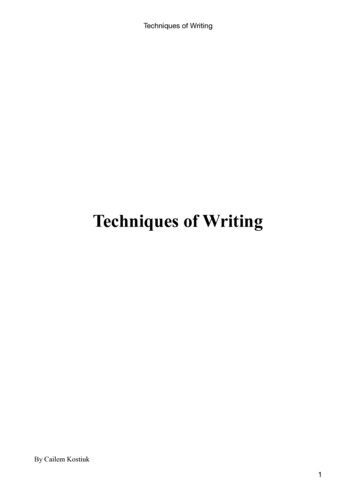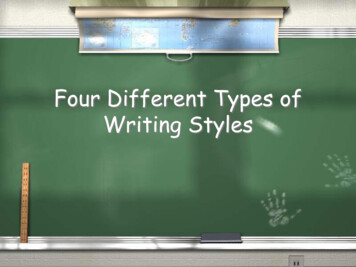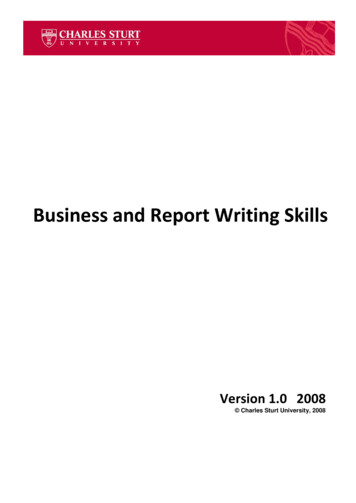
Transcription
Techniques of WritingTechniques of WritingBy Cailem Kostiuk1
Techniques of WritingTable of eplay5Ideation6prototype8Gameplay Results:10Finding11Final thoughts:11Rules (Complete, not part of assessment.)11Reference:152
Techniques of WritingThemeDuring the game, I want players learning how to use writing techniques. While playing the game,they will learn the definition of writing techniques, as well as having motivated practice at usingthem. This will prepare them for writing creatively and make them more efficient at writing a storyduring their HSC and during university if they choose.GenreAs a writing game focusing on techniques, which is basically making a game out of short poetry (Ornot as short poetry in the Poetry mode), as such a very similar 'game' is someone trying to maketheir poetry popular, like people on Tumblr.!While writing this I've come up with the idea of encouraging people to share their best lines ontwitter or snapchat because no one uses tumblr - 'no one' being a metaphor for 'less people thantwitter and snapchat'.3
Techniques of WritingMarketingMy target audience would be teachers, tutors, high school over achiever students, and creativewriting university students. I would make a kickstarter and share it to places I know hoard teachersand writers: UOW literary society Facebook page and similar groups at other universities, I'd lookfor facebook pages for teacher resources, etc. But an important marketing thing I want to use ishaving a good product that people will share on it's own, sadly that's niece and even a good productcan only be shared by the few people who see it.ProductionI've thought about different ways to market it, and the cost of such.On kickstarter, the game can come with different versions: 1 pdf of rulesPDF includes rule bookTechniques included as a list 5 Complete pdfHas the rule book,Techniques on the list,Techniques as cards,All the word cards,Links to websites that can be used for dice and timers,If I make an online version, a way to play that.Pocket VersionRules on cardsAll the game cards 13 to make. 19 to sellIt should be cheaper to ship, since it would be a small package.Complete hard copyRule bookMore scoring sheetsAll the game cards2 diceAn hourglass 25 to make, 35 to sell4
Techniques of Writing!A higher tier version could include a Digital hour glass, fancy dice, nicer cards, more cards, more scoringsheets, bigger box.Pocket version bought from makegamecards. Pocket version sounds better than 'card version', it will cheaperto make and should be cheaper to transport.Rules/GameplayStetting out the board:Sort out cards into four piles: Nouns (Things), verbs (actions words), adjectives (Describing words), andwriting techniques. Take three cards from each pile and shuffle them to have a mixed deck. Every playershould have something to write with: A laptop with batter or a pen and paper are best.Having a round:1. Draw a writing technique card, put it face up so everyone can read it.2. Everyone chooses if they'd like to play that writing technique with a noun, verb, or adjective.3. If there is a clear decision, draw from the pile people want. If there's no clear winner, take the top twofrom the mixed pile and use the bottom card. Discard the top card.4. Roll a dice to determine what word on the card will be used. If no dice is available, use the number equalto what round it is.5. Optional: Define the technique and the word.6. (Read through up to number X before doing this step.) Start a timer. (2 minutes recommended)7. Everyone writes down as many examples of the writing technique that involve the word as they can.Examples have to be two sentences. (If playing with younger kids, use easy cards where they can giveone word answers, for example, rhymes.)8. When the timer is finished, count how many examples you have. If you have an especially good exampleand the other players agree, one of them can be worth double points.9. Write down your score.10. Put the writing technique card and word card in the discard pile.11. Repeat steps 1-10 for each round.5
Techniques of WritingWin condition: Learn somethingLose condition: Not being able to overcome writers block.There are four rounds, the third is worth 1.5x the score and double points for the fourth round. The secondand third round make up the middle phase, where the third would be the rising action on Freytag's pyramid.The final phase is the final round (climax) and counting the score (resolution). The double score is alsoimportant for giving players their last chance if they would be doomed without it, which builds the tension asit's still anyone's game.Points:10 points per standard word.20 for what everyone agrees is the best example14 for the second and third best.As I said in my other assessment and blog, Writing Techniques, "The game is a paidic by nature. I can’t writedown every acceptable sentence for every combination of word and technique, it’s up to players to decide."Part of which is by design, in a creative game, I don't want to limit people's creativity beyond what they needto just go and write something.IdeationAt the start of the year I told my parents I was doing a minor in game making, they said I'd be good atmaking maths games because I've always had an outstanding mathematical ability: In year eleven I inventedan equation to work out additions to certain sequences of numbers (3 4 5 6 or 1 2 4 8 16, the lattersurprisingly easy). But I'm doing a writing subject, and one I want to improve on. One day, I wanted topractice some writing techniques, just to get a little better with them. Then, since I was doing BCM 300 Irealised I should try to make a game out of it, so I developed a 7 round game, spiced up with the final roundbeing worth triple points and the fourth being worth double. When I realised that my target audience wouldbe school kids and teachers, I shortened the game to four rounds and used Family Fued's point system,giving more in the third and even more in the fourth round. I read up on a bunch of writing techniques anddiscovered ones I hadn't heard of, and used random word generators (RWGs) to make lists of words. Thelatter improved to have specific types, as some techniques work better with nouns, for example, emotivelanguage works better if you get "red" that you could use with anger, blushing, pain of some sort, rather thana noun like "brick", unless you repeat how board, dull, or bland someone is, comparing them to a brick.Thankfully, some RWGs have the option to only include a single type of word. The diceroll was a mechanic Imade to combat the idea that someone would come across a card they couldn't use easily enough, givingthem a chance to escape it, but no certainty so that eventually they may have to face it. An advantage I didn'tthink about before was that I could add in more words without adding in cards.6
Techniques of WritingRandom Word Generator Screenshots:Not great:!!Better:!7
Techniques of Writing!Best: !prototypeMy first game was just RWGs for words and choosing the technique. Some websites have wordseasier to make techniques out of than others after my last assessment, luckily I found a bad one sodecided to pick out specific words from the generator and keep them on a list:8
Techniques of Writing!The next prototype was with people, where I learnt that the game was actually at least a little bitfun. I had to explain some techniques to people and answer questions, so the rules need moreclarity.Data:Game 1:Players: 1Thoughts: The word cards were too difficult to use.Game 2:Players: 3Thoughts: The rounds weren't long enough.Game 3:9
Techniques of Writing4 players:Thoughts: They're not playing the game how I want them to play.Game 4:Players: 1Thoughts:I forgot a few times that I was limited to only certain words.Though I wasn't timing, I felt more confident with the latter techniques.Screenshot of my last play-test before the assessment is due:!Gameplay Results:Everyone else: 5 pointsCailem: 999 pointsPeople learnt about new techniques and were always able to use them, though I only tested the hardest oneson myself. There wasn't enough replays with the same person to see if they could recall techniques a secondtime. But I believe that, even if they don't remember it consciously, they could still subconsciously whenwriting a story, or at least be better next time they play against that technique.10
Techniques of WritingFindingI haven't improved on my explaining ability as much as I'd like.Practicing techniques may also help get the hang of writing techniques in general, thereby makingthe game easier for experienced players who haven't come across certain techniques.Final thoughts:The game wouldn't look drastically different from how it is now, there's still some things I want totweak, such as putting multiple techniques onto cards like the words and having to roll for them,that way people can save money on a card. Cards with numbers 1-6 could be used in lieu of a dicefor the pocket pack.The aesthetics don't have to be big on this game, but I would like art on some of the cards.Perhaps a word card can show what the main word is, a technique card might have art related to itstechnique, or a picture of an example.Rules (Complete, not part of assessment.)Description:The aim of the game is to learn writing techniques by practicing them, it turns poetry into a competition withset words and techniques you have to use.Spirit of the game:Use positive rewardment to teach the students. For example, giving students a reward if they break theirrecord, or have a bar where the get a reward if they pass, or every x amount of points gets them a reward,such as a lolly. Or simply give them a reward for playing. The game should avoid being competitive asmuch as possible, players can count their own score, but still needs some competitiveness to get them to play.Stetting out the board:11
Techniques of WritingSort out cards into four piles: Nouns (Things), verbs (actions words), adjectives (Describing words), andwriting techniques. Take three cards from each pile and shuffle them to have a mixed deck. Every playershould have something to write with: A laptop with batter or a pen and paper are best.Having a round:12. Draw a writing technique card, put it face up so everyone can read it.13. Everyone chooses if they'd like to play that writing technique with a noun, verb, or adjective.14. If there is a clear decision, draw from the pile people want. If there's no clear winner, take the top twofrom the mixed pile and use the bottom card. Discard the top card.15. Roll a dice to determine what word on the card will be used. If no dice is available, use the number equalto what round it is.16. Optional: Define the technique and the word.17. (Read through up to number X before doing this step.) Start a timer. (2 minutes recommended)18. Everyone writes down as many examples of the writing technique that involve the word as they can.Examples have to be two sentences. (If playing with younger kids, use easy cards where they can giveone word answers, for example, rhymes.)19. When the timer is finished, count how many examples you have. If you have an especially good exampleand the other players agree, one of them can be worth double points.20. Write down your score.21. Put the writing technique card and word card in the discard pile.22. Repeat steps 1-10 for each round.There are four rounds, the third is worth 1.5x the score and double points for the fourth round. The secondand third round make up the middle phase. The final round and counting the score is the final phase.Points:10 points per standard word.20 for what everyone agrees is the best example14 for the second and third best.Words can be interpreted so any meaning of the spelling works. Words can be interpreted to be their similar,for example changing the tense of a word from present to past tense, or state, health to healthy. Any versionof the word is acceptable, but so is any euphemism, dysphemism, or type. A car can be a vehicle and viceversa. Blue can be aqua. Red can be rose coloured.Spy mode: Playable with eight people or less.Setting up:Having a round:1. Step two, "Everyone chooses if they'd like to play that writing technique with a noun, verb, or adjective."is replaced by the person going first deciding.12
Techniques of Writing2. Step three, "Roll a dice to determine what word on the card will be used. If no dice is available, use thenumber equal to what round it is." is replaced by the player then choosing to either use the word at thetop, use the word based off the number round it is, or rolling for it. (Once it is rolled, they have to use theword.)3. Between step four and five, the player opposite may change two letters in the word, so long as it stays asa real word. (Change meaning remove a letter, move a letter, add a letter, or replace a letter. Ally canbecome valley, all, sully, or y'all.Everyone rolls a dice. The highest number goes first, then it goes clockwise. There is no mixed deck in thisversion.One person picks up a card. The previous person can change one letter, so long as they can keep it a realword. Letter can be added, deleted, or changed.Poet mode- In this version, your aim is to write poetry.- During the game, you choose any of the words from the word card, there's no need to roll for it.- Pick up a word card. You choose which word to use as a motif, a motif can be used in place of any futureword card.-Set yourself a timer, five minutes is recommended. It should make a noise when the time is up.Pick up four technique cards and a motif card.The first line has to use the motif.Pick up four technique cards and a word card.Every line has to use at least one technique.Put the technique cards into the first discard pile, shuffle when they have all been used.Win condition: Learn somethingLose condition: Not being able to overcome writers block.Technique cards:-Rhyme/Pararhyme (Rhyme: The end of the word sounds similar, Pararhyme: )Synonym (Similar word)Antonym (Word with the opposite meaning)Assonance (Similar sounding vowels, "a,e,i,o,u,y" in a word. )Anagram (rearranging the letters to make a new word. You may add three letters to the word insteadof making a sentence)- Alliteration (Repeating the same letter or consonant sound at the beginning of close words. (I likeIndia in my imagination)- Simile (Saying that something is similar to something else)- Hyperbole (An exaggeration)13
Techniques of Writing- Personification Anthropomorphism (If noun or verb, personify it in different ways.Anthropomorphism is similar, but is literally giving the object the characteristic, such as giving aclock a face, rather than personification which says that the clock metaphorical smiled.)- Pun (Make a double meaning with a word. Can be done however you like.)- Analogy / Comparison (Find similar nouns or verbs and show their similarities and differences)- Cliffhanger (Make a sentence where it leaves the reader knowing something is about to happen, e.g.'I was late for the train and the doors were about to close.' 'A creepy man stopped and asked me a questionI will never forget.' 'Today is the day my wife died.')- Hook (A story opening that interests the reader or keeps them paying attention. May be similar to acliff hanger.)- Description (Describe a scene, a person, a bit of nature, the inside or outside of a house, anythingreally.)- Red herring (Either use the word to divert from a seemingly important thing, or use something elseto divert them from the important word)- Ticking clock (Find different ways to say there is a limit on the time.)- Unreliable narrator (Make a sentence where you are being bias, lying, misleading, hiding, orsugarcoating an event, character, motivation, flaw, etc.)- Audience surrogate (A character that says what the audience is thinking)- Defamiliarization (Make the object unfamiliar so we see it in a new way.)- Magic realism (Describe a real world place with a magical addition. Think local customs, religions,or urban legend)- Multiperspectivity (Have one event, but show it from multiple character's perspectives.)- Amplification (Making a general word more specific. Basic: Jumped. Jumped up, Jumped on atrampoline. Better: The vechicle -- the car -- The honda -- The honda VX10 or whatever breed it is)- Metaphor (Say something is something else for a comparison)- Bathos (Changing the writing style midway through a sentence. "The lovely lady Ariella was recentlymarried and what the hell is she wearing?")-Emotive language (First person that doesn't name an emotion but shows one.)Imagery (Invoces one of the senses, heat, sound, smell, taste, touch.)Intertextuality (Referencing another text. Can be used with other techniques.)IronyLevel of Language / Register (Using slang, colloquial, informal, or formal language.)Metonym (A word or name used instead of something that it almost is. A nickname)Parody Pastiche (Pastiche: Make the writing the way someone else would. Parody: copy somethingoff another person and put your own twist.)- Anaphora (Make a poem where every word starts with the word on the card.)- Oxymoron (Make a sentence with two words that imply the other's opposite. "It was beautifullyugly. ")- Plot twist (Say one sentence, then have a massive twist.)- Foreshadowing (Use the word in a seemingly normal way, but make it come back later and have it isoriginal meaning be more important because of the second meaning.)14
Techniques of Writing- Joke: (Set up and punchline that creates humour. No puns.)- Breaking the fourth wall (Have the first sentence immersive, then the second work not immersive bytalking to the reader or referencing something that should not be in the story universe, for examplessee Deadpool.)-ContrastFractured sentencesIncantation (A poem that gives a sense of magic or power. Imagine a spell. )Paradox (Two ideas that mean the opposite. "We were rich, but still so poor.")Reference:Kostiuk, C 2019, Writing Techniques, echniques/15
Techniques of Writing Marketing My target audience would be teachers, tutors, high school over achiever students, and creative writing university students. I would make a kickstarter and share it to places I know hoard teachers and writers: UOW literary society Faceboo










